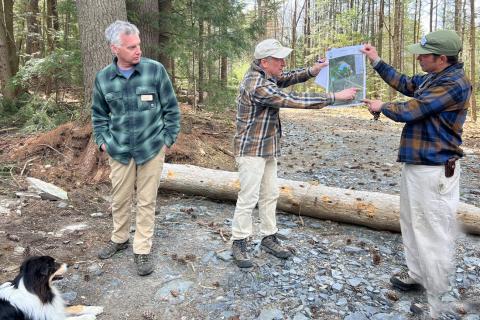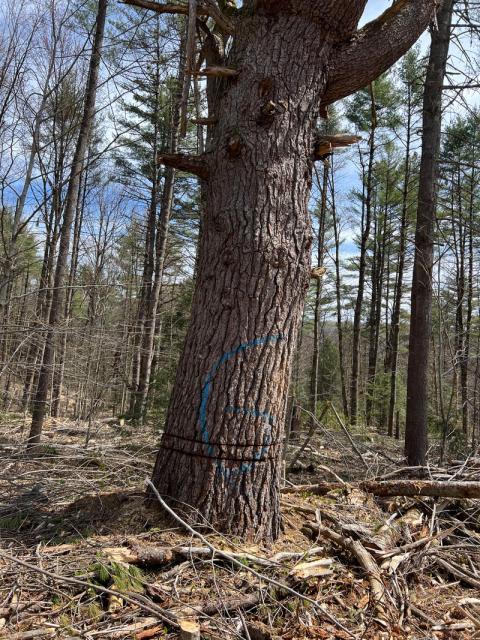Sullivan County Stowell Forest Tour
When I heard that Lionel Chute and Dode Gladders were going to be part of a group leading a walk, I immediately jumped on board without any idea where we were going or why. Lionel is the Director of Sullivan County Conservation District and Dode Gladders is the Forestry Field Specialist for UNH Extension, and both have given talks to the Grantham Garden Club so I knew I was in for a treat.

Dode Gladders, Forester, UNH Extension, Lionel Chute, Director, Sullivan County Conservation, and Jeremy Turner, Managing Forester, Meadowsend Timberlands at the Sullivan County's Stowell Forest in Unity
Our group of carpoolers from Grantham met up with Lionel and Dode in the Sullivan County owned Stowell Forest in Unity, New Hampshire. During the first bit of the walk, I didn’t like to see so many stumps and cut trees, but when as I understood the rationale behind it, I became a convert of forest management.
If Sullivan County had been interested in making a fast million, they could have hired loggers to clear cut the 98 acres of trees. In contrast, this involved thoughtful planning by many experts who walked the land, made decisions about each area, and put the health of the forest first before cutting a single tree. Key players in this transformation were Jeremy Turner and Laura French of the Meadowsend Consulting Company (a forest management company) who explained what was done and why as we walked through the site together. I was struck by how passionate they are about their work. Lionel worked closely with Jeremy and Laura during the planning and execution stages, and all are justifiably proud of what they have accomplished.
Initially we waked by a mostly cleared area where a few dozen impressive white pines stood. The plan here was to leave the best white pines as seed trees. Each year, these pine trees will produce thousands of pine cones that will each release hundreds of seeds. Since most of the trees in the area were removed, these seeds will have a better chance to germinate in the productive soil with the benefit of much less competition and lots of sunshine (which Laura called ‘reallocating the sun’). The successful seeds will inherit superior genes from their hardy parents. The land will not solely be populated by white pines. Other species of trees plus shrubs and plants will also take advantage of this opportunity to take root which will help maintain the diversity that is crucial to a healthy forest.
As we walked, we occasionally saw large white pine trees the had been girdled to gradually kill them. The standing dead trees will encourage birds such as pileated woodpeckers to create holes to feast on the insects they can hear beneath the bark. The holes created by pileated woodpeckers can benefit more than 35 species of animals and birds. In approximately 40 years, the girdled trees will fall and again help the local floral and fauna, not to mention the soil. It’s all part of the plan.

Girdled Eastern White Pine Tree
Twenty-one acres were left intact. We bushwhacked into one of the Natural Areas to visit a specimen white pine. We quietly stood together and admired the 150-year-old tree with many folks touching its bark—there was even some tree hugging. The goal of the Stowell transformation project, in addition to making a healthier forest; is to encourage people to enjoy this land: to hike, bird watch, ride trail bikes and picnic. Personally, I plan to go back and hike there often and watch what happens.
Original Grantham Garden Club Blog: https://www.granthamgardenclub.org/flowers--folklore-blog/a-forest-transformation-by-terri-munson
